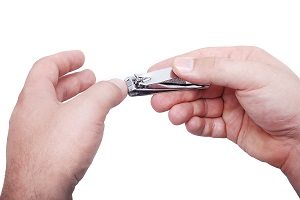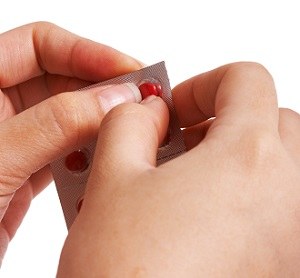Apart from the fact that maintaining thin and brittle nails is a difficult task, disfigured nails can cause low self-esteem, especially in teenagers.
Such are the effects of Koilonychia.
It also involves a lot of pain… Unfortunately, many people have little if any knowledge of this disorder, even though it is relatively common.
Attaining a higher understanding will be helpful, especially because it is sometimes indicative of a more severe medical condition.
To ensure we are all adequately prepared to prevent, diagnose, or treat, below is a detailed look at this disorder. 
What is Koilonychia?
Koilonychia is more commonly referred to as spoon nails, and it occurs mostly in the fingernails.
It is the abnormal development of nails, often resulting in a depressed or concave formation.
This condition shows itself in concaved and thinned nails with raised edges, a shape that is almost the same as that of a spoon.
This nail problem causes the center portion of nails to form in an indented fashion. Spoon nails is a common disfigurement where the plate, normally of a convex contour, switches to one that has a concavity in the center, lateral margins, and upturned distal.
To some extent, Koilonychia is the exact opposite of nail clubbing.
In its early stages, the affected nails may chip or break easily because they are usually very thin and quite brittle. The concave formation of nails due to this disorder is actually a direct result of abnormalities in the nail beds.
The nails form over nail beds that have developed waves or ridges, resulting in the formation of strange curves. In such cases, the nails’ center develops a deep indentation that is capable of holding water drops without spilling.
There may even be flares to the sides or cracks running the entire length of the nail. Apart from being highly visible to the naked eye, flares and cracks can keep developing over time.
Although flares and cracks can be present in every nail on an individual’s hands or feet, they can also be present in a few or only one of the nails.
The number of nails that show signs of Koilonychia depend on the cause.
For instance, the number of affected nails won’t be the same if the disorder is genetic, a result of nail biting, or due to trauma. This condition is known to affect everything including the shape, color, texture, and thickness of both toenails and fingernails.
It typically takes long for the affected nails to regain normalcy. Apart from being genetic as an autosomal dominant trait, Koilonychia can also be linked to other disorders.
For instance, acquired Koilonychia is sometimes associated with iron deficiency anemia.(1,2)
As such, it can also indicate the presence of other medical conditions within the affected individual. This nail disease occurs more commonly among young infants and often disappears as they age.(3)
In such cases, it should not raise concern, especially since it doesn’t require treatment. However, this is usually a problem that needs resolution when it occurs in adults or older children.
You can diagnose mild cases of this condition by testing to see whether the concave indention on the nail plate is capable of retaining a drop of water.
 Symptoms
Symptoms
Several symptoms can point to Koilonychia as the problem.
The thinning of affected nails is the most obvious sign, the occurrence of which is always prior to the curling of edges.
Spoon-shaped nails are a result of curled edges. Throughout the disorder’s course, the affected nails will begin to change color while showing slight alterations in shape.
A further detachment of the affected nails from the nail bed often causes pain and can even lead to the occurrence of an infection.
The following are signs and symptoms:(4,5,6)
» Spoon-shaped nails
» Brittle, soft, and thinning nail plates
» Concavity in the center of nails
» Detachable nails or nails that can come off
» Signs of malnourishment
» Nails that have embossed edges
» Discoloration underneath the affected nails, mostly caused by a secondary infection
» Pain around the affected nails, especially if they are detached from nail bed
However, some of the symptoms mentioned above can be the result of other conditions.
For instance, spoon nails can be triggered by picking the skin beneath the visible portion of a nail, trauma, or chronic rubbing while covering nails with excess moisture or nail polish might result in brittle nails that peel at the edges.
Once identified, seeking immediate medical attention is of uttermost importance, especially since apart from its association with Plummer-Vinson syndrome (also called Paterson–Brown–Kelly syndrome or sideropenic dysphagia), this disorder is also an indicator of anemia and further iron deficiencies.
Koilonychia needs to be treated as quickly as possible!
Causes
This is a genetic problem that might arise from issues with the kidneys or musculoskeletal system.
Although iron deficiency anemia might cause this kind of problem, it can also be congenital. Koilonychia is therefore linked to several syndromes, conditions, and causes including:(3,6,7,8,9,10)
» Musculoskeletal conditions
» Impaired circulation peripherally
» Systemic lupus erythematosus
» Hypoplastic Patella
» Thyroid dysfunction
» Hemochromatosis
» Raynaud’s disease
» Renal disease
» Nail Patella Syndrome
» Contact dermatitis
» Excessive use of certain soaps or oils
» Direct trauma
» Diabetes mellitus
» Celiac disease
Below are some of the most common causes:(2,3,6,7,10)
» Damaging event
» Cheilosis
» Pica
» Glossitis
» A major metabolic condition
» Chemotherapy
» Malnutrition
» Iron deficiency
» Exposure to petroleum products
» Liver disease
Koilonychia can also be caused by medical conditions created by unbalanced diets, problems with absorption, inadequate intake of nutrients, inability to digest nutrients, digestive issues, or anything that is capable of hindering the proper development of nails, nail biting included.
Prevention
If you have not yet developed Koilonychia, then prevention measures are definitely worth considering.
Looking into preventative techniques is even more important if someone in your family has this disorder.
There are several different ways to prevent the development of this nail disorder, and most of them are quite simple.(5,6,7,11)
Self-care plays an important part in the prevention of nail diseases. For starters, you need to avoid nail biting, a habit that is shown to be a common contributory factor.
You also need to improve the nutrients you ingest.
You can achieve this by including foods that are high in iron and vitamins in your everyday diet. The inclusion of these nutrients in your children’s diet is also necessary.
Contact dermatitis and excessive use of certain soaps or oils can cause this condition, wearing gloves whenever you are working with chemicals or liquids solutions of any kind is, therefore, effective as a preventive measure.
If you happen to be showing the preliminary signs of Koilonychia or your children seem to have its symptoms, you should consult your doctor for advice on how to prevent further advancement.
If you think you have this nail problem, visiting your doctor as soon as you can is also of utmost importance.
Determining whether or not the condition is indicative of any other medical disorder is necessary. It could be that your spoon nail problems and symptoms are a sign of one or several of the severe disorders previously mentioned.
More importantly, you should receive proper treatment to ensure you avoid the pain associated with Koilonychia or more advanced issues.
If you are showing symptoms, the sooner you visit your doctor, the sooner they can assist your recovery process.
Treatment
Once recognized, you will need to manage your condition as quickly as possible.
A prescribed iron replacement treatment needs to be taken not less than 30 minutes before meals.
If your primary physician gives you iron supplements, you must take them exactly as instructed to prevent the occurrence of issues associated with too much iron.
Remember not to take iron supplements with drinks like coffee or tea since they can inhibit the absorption of iron.
You can also treat mild cases of Koilonychia at home with the help of home remedies that encourage the natural growth of nails.
Methods for treating or preventing include:(5,6,7,11)
» Consuming sufficient amounts of iron and vitamins
» Cutting your nails short
» Using fresh cream to moisturize your nails
» Applying some lemon to your nails
» Massaging your nails gently after applying small amounts of lavender oil
Other helpful measures include:
» Wearing proper-fitting shoes that don’t crowd your toes together if you have abnormalities caused by ingrown toenails
» Applying cold cream to your nails after your daily bath to keep them soft and smooth
» Wearing gloves while working with the harsh chemicals commonly found in washing powders and soaps
» Refraining from the habit of biting nails
» Cutting your nails straight across the top
» Taking prescribed iron and vitamin supplements
Rating | Product | Our Rating | Price on Amazon |
|---|---|---|---|
#1 | |||
#2 | |||
#3 | |||
#4 | |||
#5 |
Conclusion
You can minimize the chances of Koilonychia by ensuring your nails are always clean.
Treating the source is important if the issue is an after effect of this disorder, especially since this will automatically eliminate the side effects.
For those with Koilonychia caused by genetics, proper nail care and healthy foods are necessary precautions before it develops into a disease.
Remember, consulting your doctor is always your best option!
Read more:
References
(1)Barnett JM, Scher RK, Taylor SC. Nail cosmetics. Dermatol Clin. 1991;
(2)”ncbi.nlm.nih.gov/pmc/articles/PMC3051313/
(3)”podiatrytoday.com/blogged/how-diagnosis-koilonychia-may-indicate-systemic-disease
(4)”rightdiagnosis.com/h/hereditary_koilonychia/symptoms.htm
(5)”beautyhealthtips.in/koilonychias-spoon-nails-causes-and-home-remedies/
(6)”epainassist.com/skin/koilonychia-or-spoon-nails
(7)”nytimes.com/health/guides/symptoms/nail-abnormalities/overview.html
(8)”nhs.uk/conditions/nail-abnormalities/Pages/Introduction.aspx
(9)”ncbi.nlm.nih.gov/pubmed/15053406
(10)”ncbi.nlm.nih.gov/pmc/articles/PMC3442766/
(11)”healthresource4u.com/koilonychia-causes-picture-symptoms-treatment.html
Leave Feedback: Was this article helpful?


 Symptoms
Symptoms
